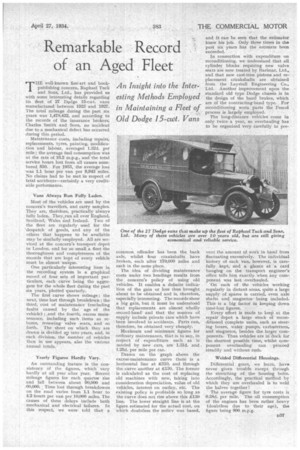Remarkable Record of an Aged Fleet
Page 123

If you've noticed an error in this article please click here to report it so we can fix it.
HE well-known fine-art and book
publishing concern, Raphael Tuck and Sons, Ltd., has provided us with some interesting details regarding its fleet of 27 Dedge 11i-cwt. vans manufactured between 1923 and 1927. The total mileage during the past six years was 1,478,422, and according to the records of the insurance brokers; Charles Smith and Sons, no accident due to a mechanical defect has occurred during this.period.
Maintenance •costs, including repairs, replacements, tyres, painting, modification and labour, averaged 1.82d. per mile; the average fuel consumption was at the ea te of 1.6.2 m.p.g., and the total Service hours lost from all causes numbered 830. For 1933, the average loss was L1 hour per van per 9,943 mileS. No claims had to be met in respect of fatal accidents—certainly a very creditable performance.
Vans Always Run Fully Laden.
Most of the vehicles are used by the concern's travellers, and carry samples. They are, therefore, practically always fully laden. They Jun all over England, Scotland, Wales and Ireland. Two of the fleet are regularly used for the despatch of goods, and any of the others that happens to be available may be similarly employed. All are serviced at the concern's transport depot in London, and for so small a fleet the thoroughness and completeness of the records that are kept of every vehicle must be almost unique.
One particularly interesting item in the recording system is a graphical record of four sets of important particulars, each curve being the aggregate for the whole fleet during the past six years, plotted quarterly.
The first curve shows mileage ; the next, time lost through breakdown; the third, cost of maintenance (excluding faults caused by the age of the vehicle) ; and the fourth, excess maintenance, including such items as rebores, renewing valve seats, and so forth. The sheet on which they are drawn is divided up into years, and, in each division, the number of vehicles then in use appears, also the various animal totals.
Yearly Figures Hardly Vary.
An outstanding feature is the consistency of the figures, which vary hardly at all year after year. Recent mileage figures for each quarter rise and fall between about 90,000 and 60,000. . Time lost through breakdowns on the road varies from 1.1 hour to 4.2 hours per van per 10,000 miles. The causes of these delays include both mechanical and electrical failures. in this respect, we were told that a conunon offender has been the back axle, whilst four crankshafts have broken, each after 170,000 miles and each in the same place.
The idea of dividing maintenance costs under two headings results from the concern's policy of using old vehicles. It enables a definite indication of the gain or loss thus brought about to be obtained and is, therefore, especially interesting. The records show a big gain, but it must be understood that replacements are almost wholly second-hand and that the sources of supply include private cars which have been involved in accidents. Parts can, therefore, be obtained very cheaply.
Maximum and minimum figures for ordinary maintenance, that is to say, in respect of expenditure such as is needed by new cars, are 1.31d. and 1.25d, per mile per car.
Drawn on the graph above the excess-maintenance curve there is a horizontal line at £310, and through the curve another at £130. The former is calculated • as the cost of replacing old machines with new, taking into consideration depreciation, value of old vehicles, interest on outlay, etc. The existing policy is profitable so long as the curve does not rise above this £130 line. The lower straight line is at the figure estimated for the actual cost, on which .doubtless the -policy was based, and it can be seen that the estimator knew his job. Only three times in the past. six years has the estimate been exceeded. .
In connection with expenditure on reconditioning, we understand that all cylinder blocks requiring new valve seats are now treated by Earimar, Ltd., and that new cast-iron pistons and replacement crankshafts are obtained from the • Laystall Engineering Co., Ltd. Another improvement upon the standard old type Dodge chassis is in the design of the hand brakes, which are of the contracting-band type. For reconditioning worn parts the Fescol process is largely employed.
The long-distance vehicles come in only twice a year, so overhauling has to be organized very carefully to pre
vent the amount of work in hand from fluctuating excessively. The individual history of each van, however, is carefully kept, and a glance at a card hanging on the transport engineer's office tells him exactly when any component was last .overhauled. •
On each of . the vehicles working regularly in distant areas, quite a large supply of spares is carried, even axle shafts and magnetos being included. This is a big factor in keeping down time-lost figures.
Every effort is made to keep at the repair depot a large stock• of reconditioned complete units, such as steering boxes, water pumps, carburetters, and magnetos, besides the larger. components. Thus vehicles are in 'dock for the shortest possible time whilst component overhauling can proceed steadily and without rush.
Welded Differential Housings.
Differe.ntial gears, we learn, have given trouble except through the stretching of the housing bolts. Accordingly, the practical method by which they are overhauled is to weld the halves together I The average figure for tyre costs is 0.38d:per mile. The oil consumption of the engines has been rather heavy (doubtless due to their age), the figure being 800 m.p.g.




















































































































































































